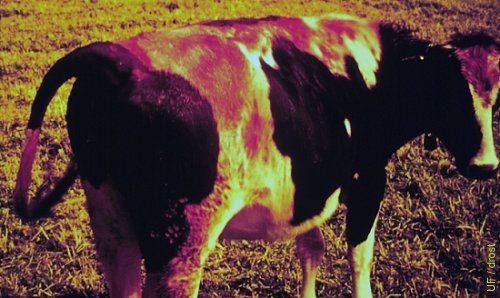The Visual Guide to
Bovine Reproduction
Estrus Detection: Estrus Detection Aids
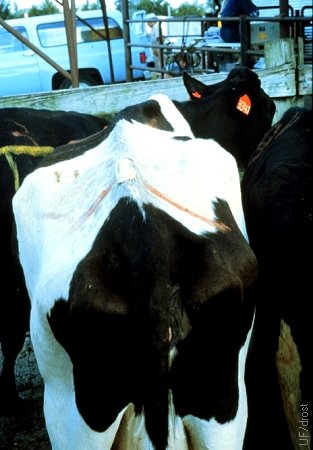
Heat Mount Detector.
A pressure sensitive heat mount detector patch (KaMar) is glued to the tailhead of the cow.
Drost M (1974)
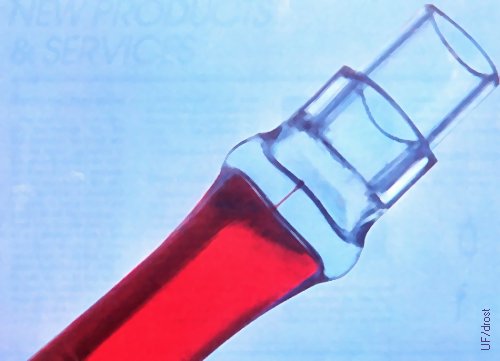
Close-up of Dye Capsule.
Red dye is contained in a soft compressible capsule that is connected by a hairline channel via a hard cylindrical tube to an outer compartment (not shown). Sustained pressure, as from a mounting animal, is required to express the contents which are then readily visible in a compartment glued to the tailhead of the cow. The entire pressured sensitive device is called a KaMar (trade name).
Drost M (1979)

Estrus Detection Patch Before Activation.
The thin, light blue, outer layer of this estrus detection patch is readily rubbed off if the cow is mounted when she is in heat. The entire friction sensitive device is called an Estrotect patch (trade name).
Dingus TB (2011)
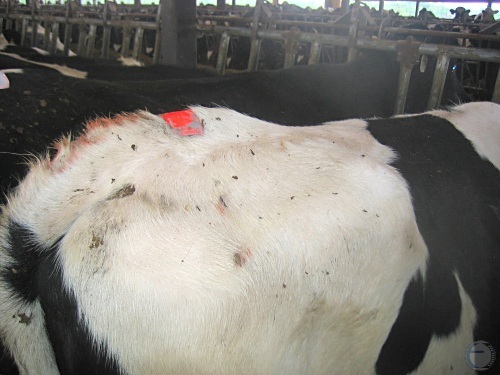
Activated Estrus Detection Patch.
The thin, blue, outer layer of this estrus detection patch is readily rubbed off if the cow is mounted when she is in heat. This reveals the orange color beneath. The entire friction sensitive device is called an Estrotect patch (trade name).
Dingus TB (2011)
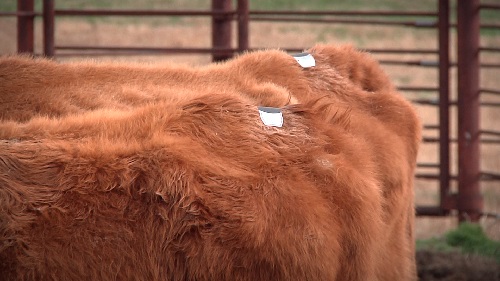
Unactivated breeding indicators on beef cows close up.
Unactivated breeding indicators on beef cows close up.
Dingus TB (2019)

Activated Detection Patch Close Up.
The lighter colored outer layer of the patch was partially rubbed off when the cow was mounted when she came into heat. This revealed the yellow color beneath. The entire friction sensitive device is called an Estrotect patch (trade name).
Dingus TB (2011)
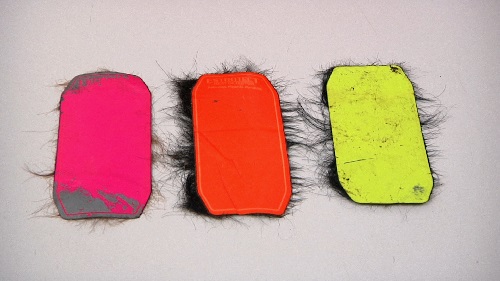
Activated breeding indicators close up
Activated breeding indicators close up.
Dingus TB (2019)
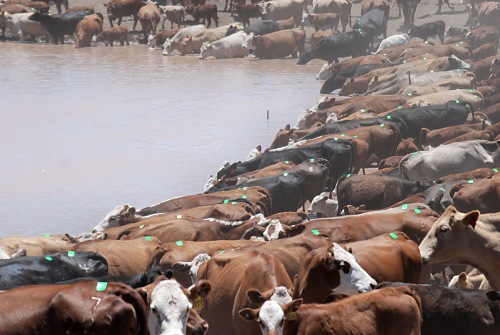
Estrus Detection Patches in Beef Cows.
Large herd of nonpregnant beef cattle wearing green estrus detection patches The friction sensitive devices are called Estrotect patches (trade name).
Dingus TB (2011)
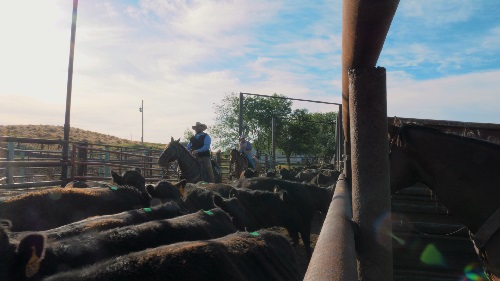
Beef cattle in corral with breeding indicators.
Beef cattle in corral with breeding indicators.
Dingus TB (2019)
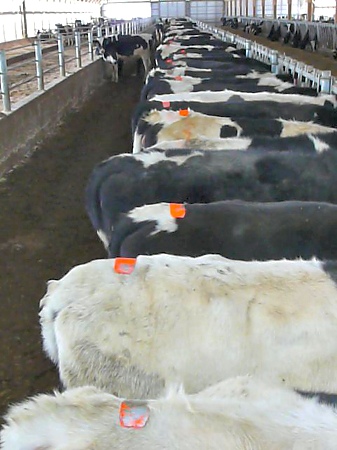
Estrus Detection Patches in Dairy Cows.
Easy to read orange estrus detection patches to monitor estrous behavior in a dairy herd. The friction sensitive devices are called Estrotect patches (trade name).
Dingus TB (2011)

Tail Head Painting 1.
Tail head painting as an aid to estrus detection. Oil based paint is used, subsequently to be covered with a layer, of a different color, of chalk.
Drost M (1979)
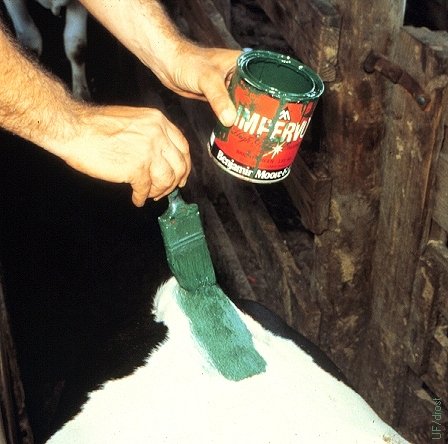
Tail Head Painting 2.
Tail head painting with an oil based paint as an aid to estrus detection. Subsequently a second layer of a different color will be applied with a crayon.
Drost M (1979)

Tail Head Painting 3.
Tail head painting with an oil based paint as an aid to estrus detection. Subsequently a second layer of a different color is applied with a crayon.
Drost M (1979)
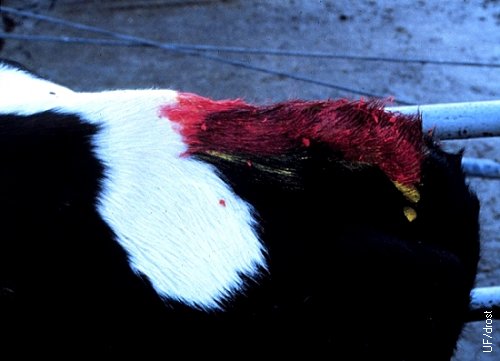
Tail Head Painting 4.
Close-up of an fresh intact two-tone mark of yellow oil paint covered by red crayon.
Drost M (1979)
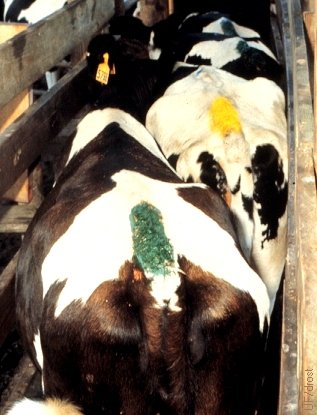
Tail Head Painting 5.
Tail head painting with an oil based paint as an aid to estrus detection. Subsequently a second layer of a different color is applied with a crayon.
Drost M (1979)
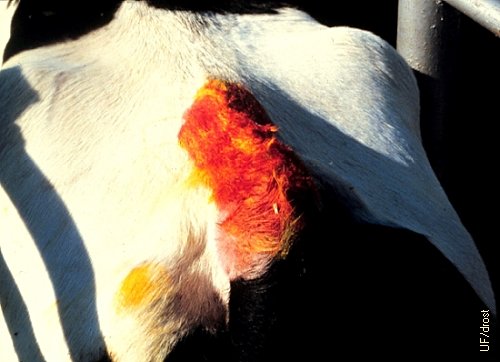
Tail Head Painting 6.
Some of the red crayon has been rubbed off indicating that some, limited mounting has taken place, and suggesting that the cow is coming into estrus.
Drost M (1979)
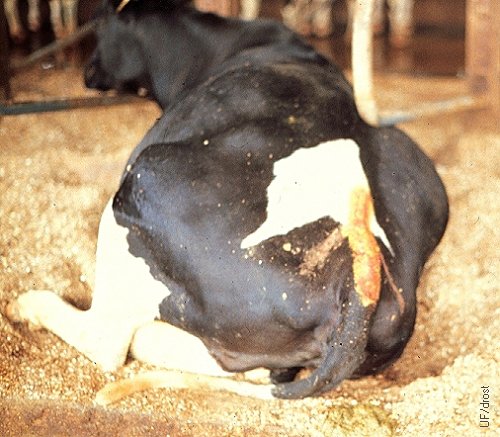
Tail Head Painting 7.
Some of the top red crayon color has been rubbed off indicating that some riding has taken place, and suggesting that the cow is starting to come into estrus.
Drost M (1979)
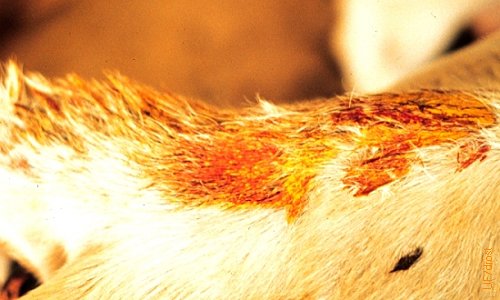
Tail Head Painting 8.
Close-up of a two-tone paint and crayon mark that has been partially rubbed off as a result of riding suggesting early attempts at mounting. Cow would appear to not be in full blown heat yet.
Drost M (1979)
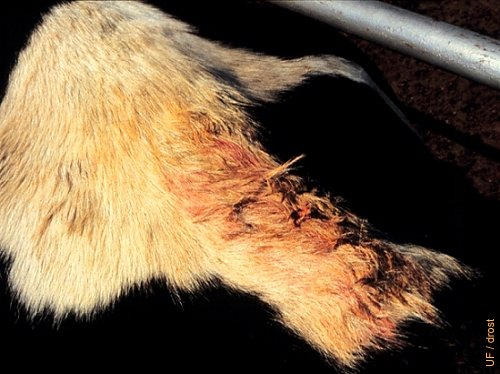
Tail Head Painting 9.
Almost all of the paint and chalk have been rubbed off by repeated mounts.
Drost M (1979)
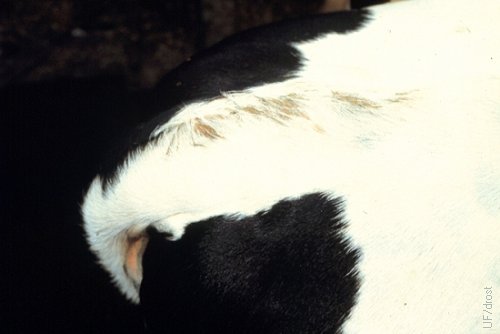
Tail Head Painting 10.
Nearly all of both colors has been rubbed off indicating that repeated riding has taken place and suggesting that the cow is in estrus.
Drost M (1979)
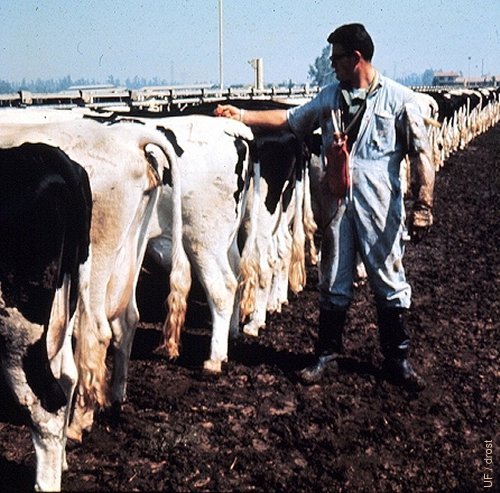
Tail Head Chalking 1.
With cows in lock-up stanchion tail heads are easily marked with a crayon and inspected for scuff marks.
Leck A (1973)
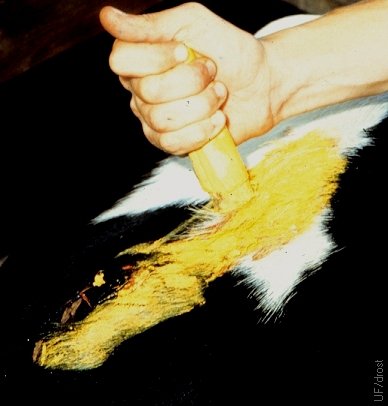
Tail Head Chalking 2.
Tail head marking with a crayon or "chalk" as an aid to estrus detection.
Leck A (1973)
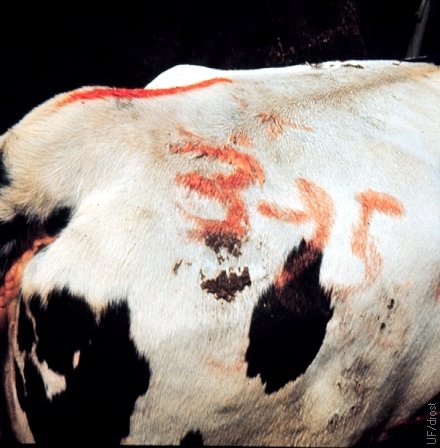
Tail Head Chalking 3.
Tailhead marked with crayon to facilitate estrus detection.
Leck A (1973)
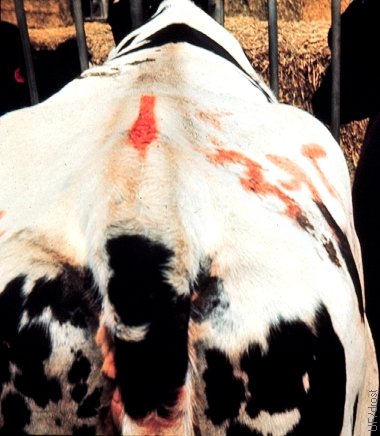
Tail Head Chalking 4.
Tailhead marked with crayon to facilitate estrus detection.
Leck A (1973)
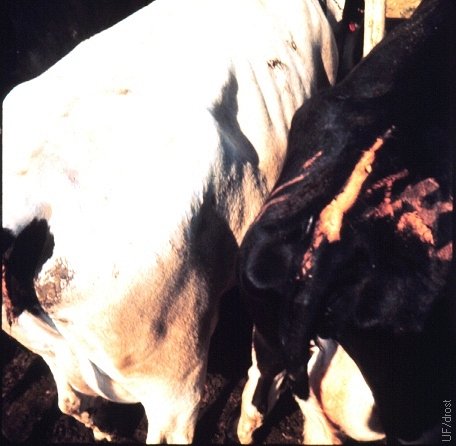
Tail Head Chalking 5.
The white cow is in estrus. She has lost the tailhead marks compared with the cow next to her that is not in heat, because she was ridden by other cows.
Leck A (1973)
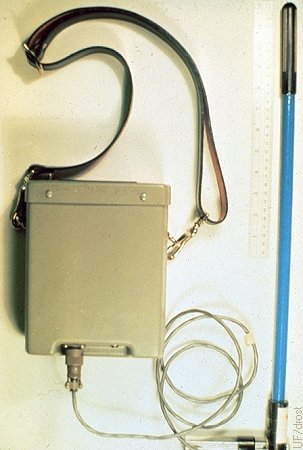
Vaginal Probe and Electrical Resistance Meter.
Vaginal probe and the electrical resistance meter. There is a direct correlation between the electrical resistance of the vaginal secretions and the progesterone concentration in plasma or milk.
Foote RH (1973)
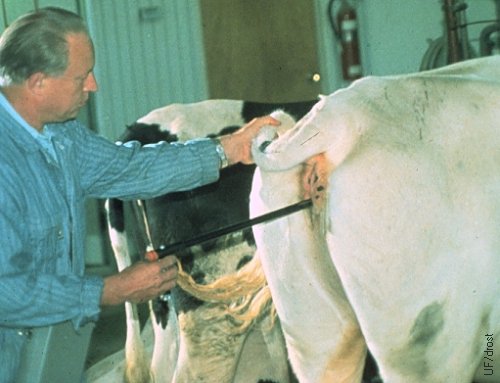
Measuring Electrical Resistance in the Vagina.
Dr RH Foote inserts a vaginal probe to measure the electrical resistance of the vaginal secretions. There is a direct correlation between the electrical resistance of the secretions and the progesterone concentration in the milk or plasma.
Foote RH (1973)
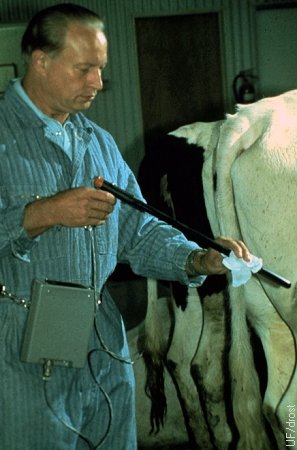
Measuring Electrical Resistance in the Vagina.
Dr RH Foote cleans the vaginal probe after measuring the electrical resistance of the vaginal secretions. There is a direct correlation between the electrical resistance of the secretions and the progesterone concentration in the milk or plasma.
Foote RH (1973)
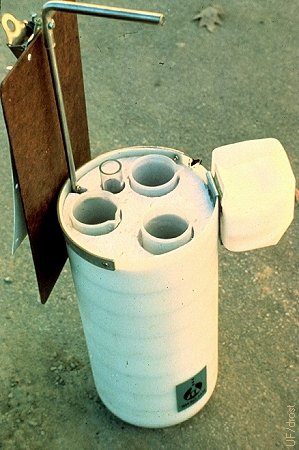
Unit for Disinfection of the Vaginal Probe.
Unit for disinfection of the vaginal probe between cows. Three compartments. The probes can be used in rotation.
Foote RH (1973)
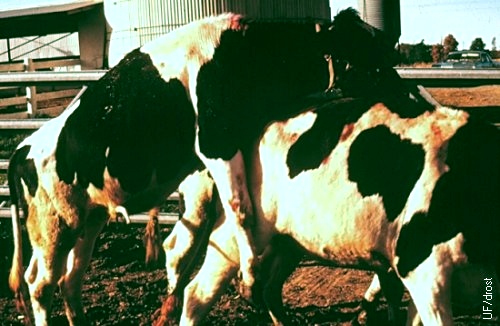
Teaser Bull with Lateral Deviation of the Penis.
Teaser bull with a surgically deviated penis mounts a heifer in estrus. This is a non-entry teaser. The bull is wearing a chinball marking harness to record his actions.
Drost M (1973)
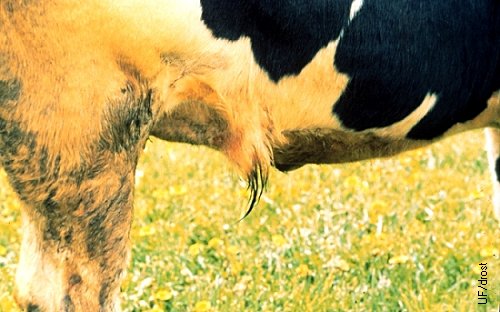
Teaser Bull with Lateral Deviation of the Prepuce.
The prepuce and penis of this bull were surgically relocated in a right dorso-lateral direction to make intromission impossible, and to prevent the spread of sexually transmitted diseases. The penis is fully capable of erection and extension without discomfort to the bull. The bull is otherwise intact and ejaculation (into the air) takes place.
Drost M (1983)

Left Lateral Deviation of the Penis.
Left dorso-lateral deviation of the penis to prevent intromission. The penis is erected and extended.
Ott R (2013)

Lateral Deviation of the Penis 1.
The bull is heavily sedated to the point he lies down. He is then placed in dorsal recumbency. The abdomen is clipped and scrubbed from the xiphoid process to the base of the scrotum. The initial incision is skin deep and encircles the prepuce. The skin is also incised from the caudal most part of the circle to the base of the scrotum.
Drost M (1983)
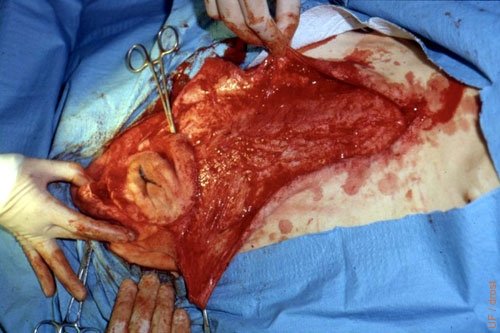
Lateral Deviation of the Penis 2.
Skin flaps are dissected free on both sides and deflected to the sides. Occasional bleeders are occluded with hemostats.
Drost M (1983)
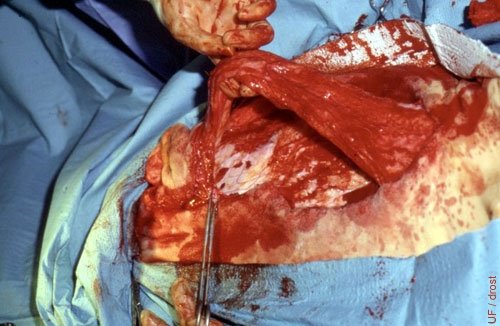
Lateral Deviation of the Penis 3.
The penis and the sheath are dissected free from the abdominal fascia.
Drost M (1983)
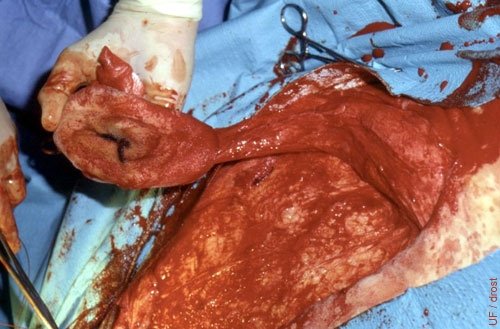
Lateral Deviation of the Penis 4.
The entire prepuce and the sheath, containing the penis, have now been dissected free.
Drost M (1983)

Lateral Deviation of the Penis 5.
The free (bloody) prepuce and sheath are laid at a 45 degree angle on the surface of the surgically prepared skin to mark its new direction.
Drost M (1983)
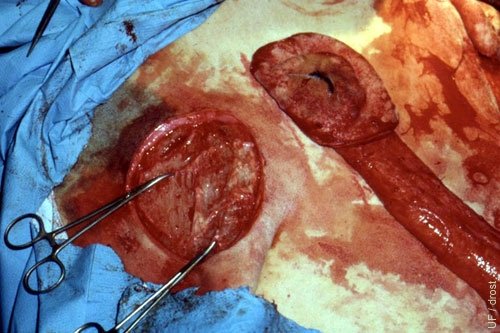
Lateral Deviation of the Penis 6.
A circle of skin, slightly smaller than the circle of the prepuce has been removed in the lower flank. It will be the end of the tunnel.
Drost M (1983)
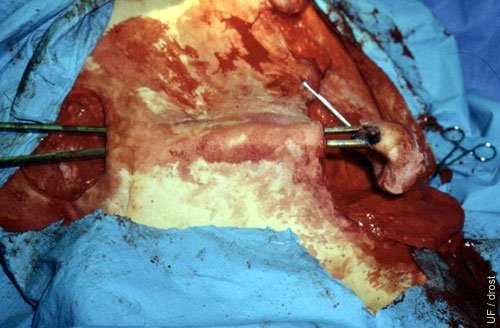
Lateral Deviation of the Penis 7.
A large cervical forceps is used to make a subcutaneous tunnel from the the circle in the lower flank to the base of the scrotum. The free prepuce and sheath are then pulled through the tunnel to their new location.
Drost M (1983)
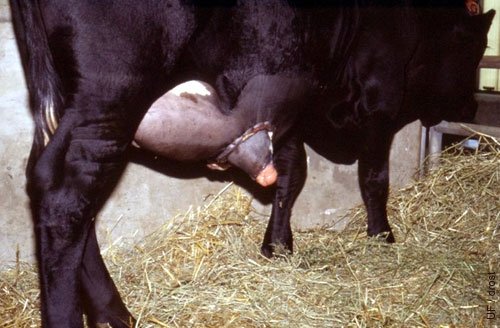
Lateral Deviation of the Penis 8.
Post-operative swelling at 24 hours. This swelling will subside over the next two days as circulation of the cutaneous tissues re-establishes itself. It is important that the bull can urinate freely.
Drost M (1983)

Lateral Deviation of the Penis 9.
Right lateral deviation of the prepuce and penis in a 2-year old Brahman teaser bull. Shown three days after surgery was performed.
Drost M (1983)

Penile Translocation 1.
Positioning of the teaser bull for surgical translocation of the penis and epididymectomy. Surgical preparation.
Shipley C (2006)
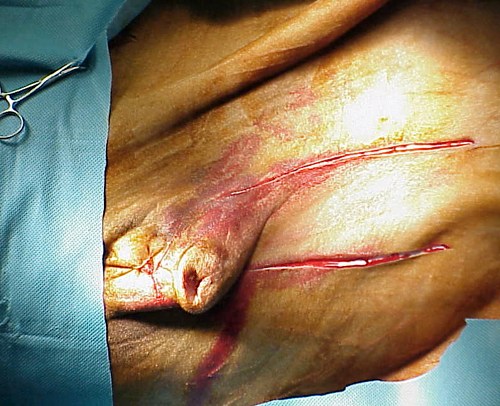
Penile Translocation 2.
Elliptical skin incision between the umbilicus and the prepuce and then extending posteriorly along the sheath of the penis.
Shipley C (2006)
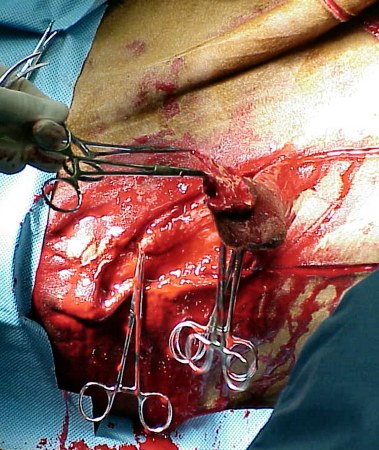
Penile Translocation 3.
Dissecting the prepuce and the penis with the overlying skin free from the abdominal wall leaving the sheath intact.
Shipley C (2006)
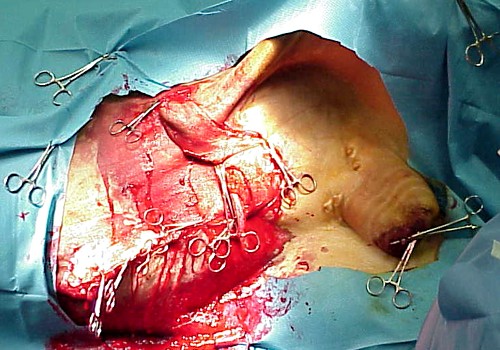
Penile Translocation 4.
The midline incision has been clamped together and the prepuce and penile sheath have been redirected at a 45 degree angle towards the left flank.
Shipley C (2006)
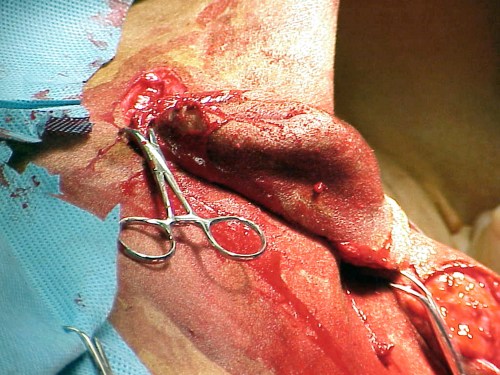
Penile Translocation 5.
The prepuce is sutured in place in the circular area in the left flank.
Shipley C (2006)
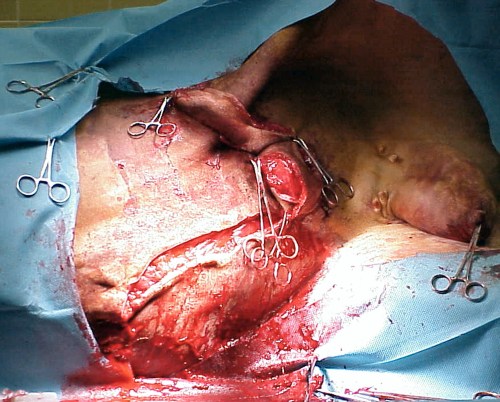
Penile Translocation 6.
After the prepuce and the penile sheath have been dissected free they are redirected at a 45 degree angle to the left flank.
Shipley C (2006)

Penile Translocation 7.
The midline has been closed with a lock stitch pattern. The penis has been redirected to the flank.
Shipley C (2006)
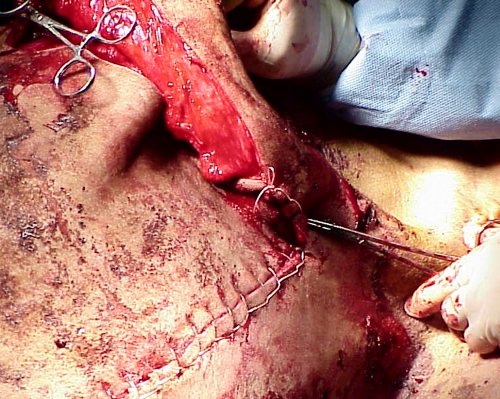
Penile Translocation 8.
Next step is to suture the skin edges of the translocated sheath into place.
Shipley C (2006)
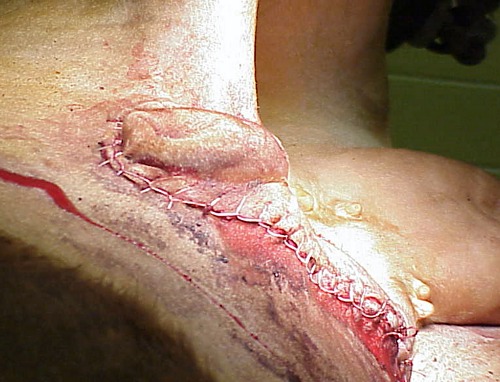
Penile Translocation 10.
Close up of the prepuce in its new location just above the left flank fold.
Shipley C (2006)

Chinball Marking Harness.
Filling of the chinball marking harness with marking fluid or paint. The spring loaded ball is depressed and paint is poured or squirted in.
Drost M (1973)
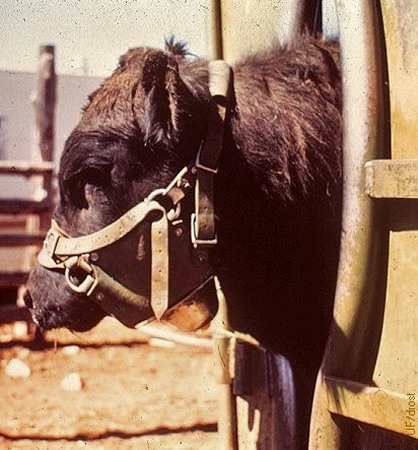
Chinball Marking Harness in Place.
Chinball marking harness fitted on a teaser bull.
Drost M (1973)
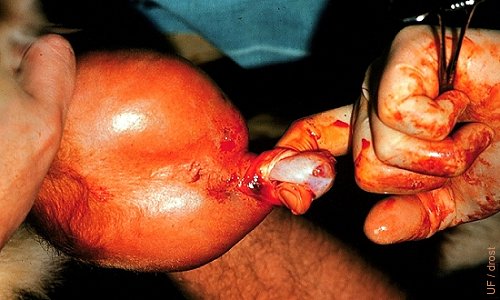
Caudal Epididymectomy.
After a 3 cm incision has been made directly over the tail of the epididymis, the finger is inserted between the epididymis and the testis and the tail is freed.
Drost M (1974)
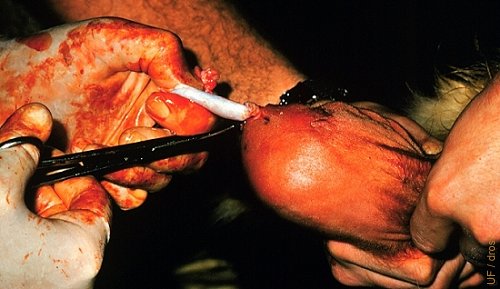
Caudal Epididymectomy.
After the tail of the epididymis has been freed and extended it is ligated and then severed distal to the ligature with a nonabsorbable suture material.
Drost M (1974)
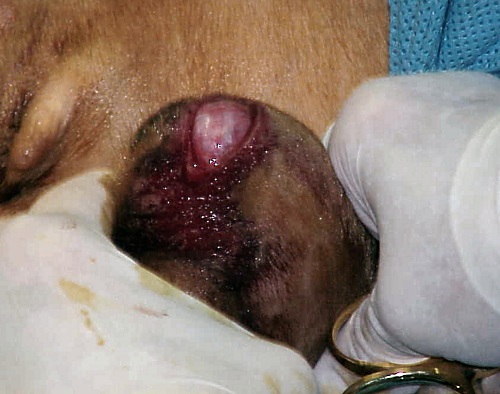
Epididymectomy 1.
The testis is squeezed into the bottom of the scrotum and a 3 cm incision is made over the tail of the epididymis.
Shipley C (2006)

Epididymectomy 2.
The cauda epididymidis is grasped with a large towel forceps, pulled out, and then dissected free with a pair of scissors.
Shipley C (2006)
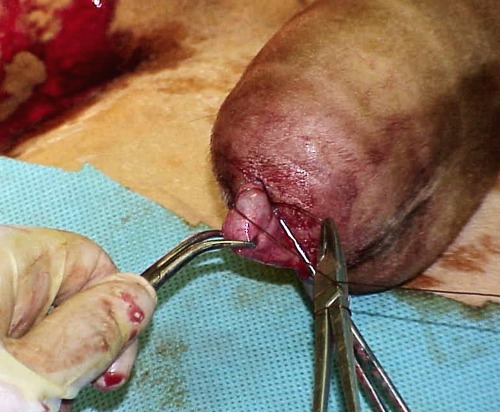
Epididymectomy 3.
The epididymis is clamped off dorsal to its tail and a suture is placed proximal to the forceps.
Shipley C (2006)
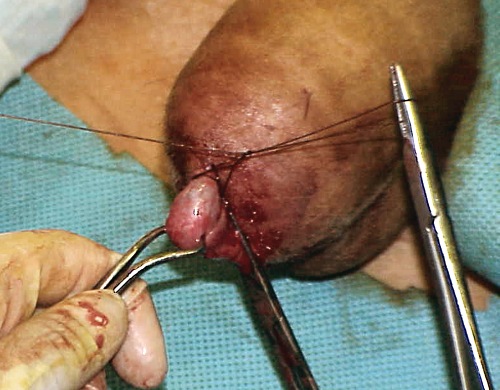
Epididymectomy 4.
The epididymis has been clamped off dorsal to its tail and a suture is placed proximal to the forceps.
Shipley C (2006)
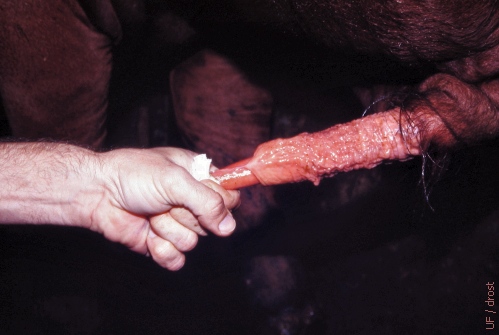
Manual Extension of the Penis.
Transrectal palpation of the root of the penis may cause the onset of erection and make the tip of the penis appear at the prepuce where it can be grasped with a piece of gauze. The penis can then be manually extended for examination over its entire length, or for surgical procedures.
Drost M (1974)
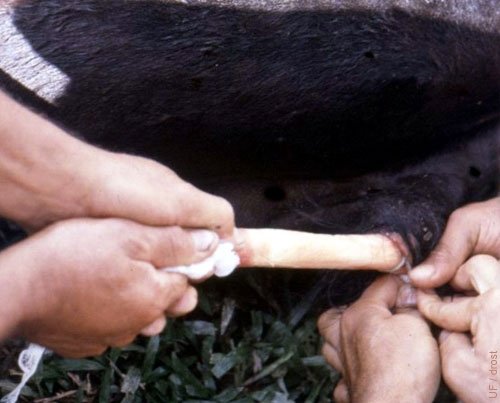
Dorsal Ligament Resection 1.
With the bull in lateral recumbency under heavy sedation, the penis is manually extended and a tourniquet is applied.
Larsen RE (1983)
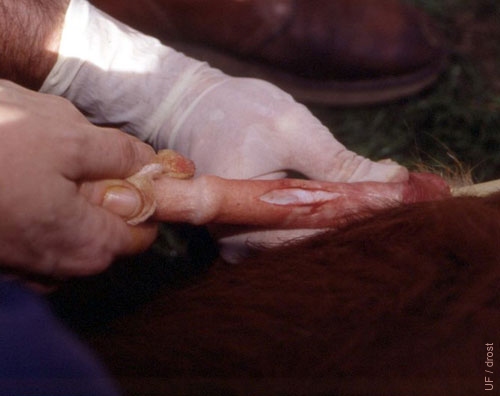
Dorsal Ligament Resection 2.
A 8 cm dorsal longitudinal incision is made through the epithelial tissues covering the penis.
Larsen RE (1983)
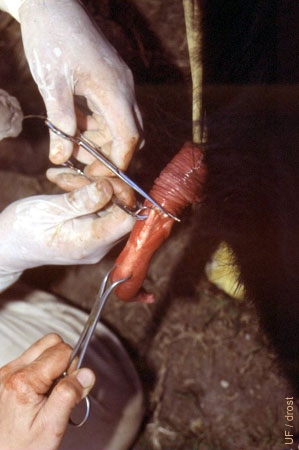
Dorsal Ligament Resection 3.
The dorsal ligament is surgically exposed. The penis is kept extended with a large towel forceps clamped on to the distal portion of the dorsal ligament of the penis.
Larsen RE (1983)
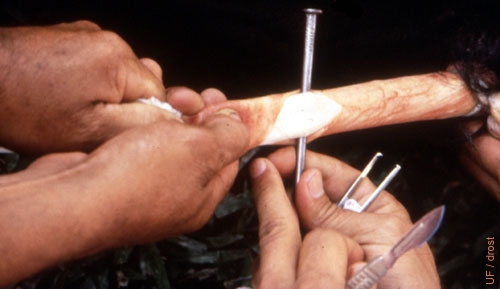
Dorsal Ligament Resection 4.
A sterile new nail is inserted ventral to the dorsal ligament of the penis to facilitate further dissection.
Larsen RE (1983)

Dorsal Ligament Resection 5.
The distal portion of the dorsal ligament of the penis is transsected along the side of the nail which was placed ventral to the ligament.
Larsen RE (1983)
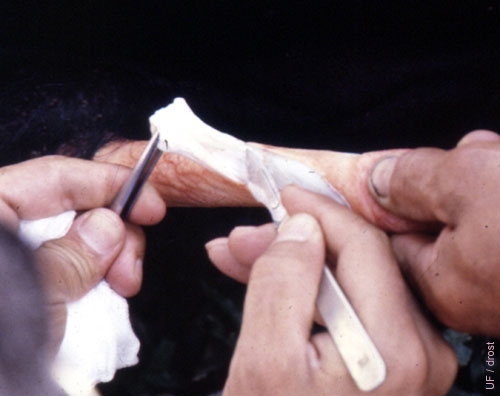
Dorsal Ligament Resection 6.
A 5 cm section of the dorsal ligament is transected.
Larsen RE (1983)

Dorsal Ligament Resection 7.
After removal of a section of the dorsal ligament of the penis, the incision is closed.
Larsen RE (1983)
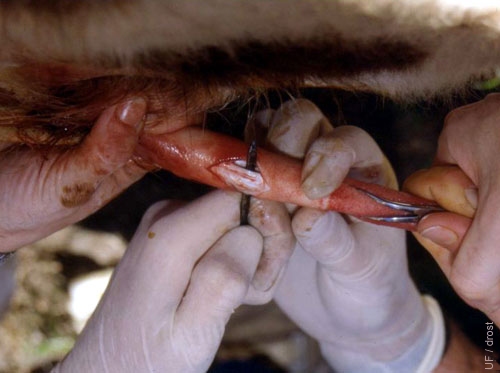
Dorsal Ligament Resection 8.
A sterile nail is inserted ventral to the dorsal ligament or the penis to aid in the exposure of a section of the ligament prior to removal.
Larsen RE (1983)
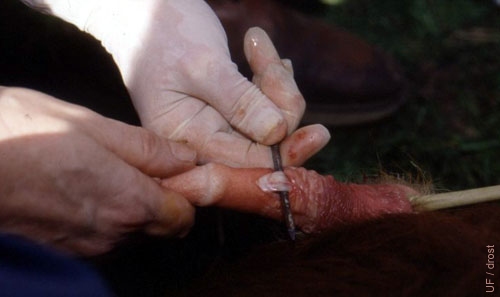
Dorsal Ligament Resection 9.
A sterile nail is inserted to aid in isolation of the dorsal ligament.
Larsen RE (1983)
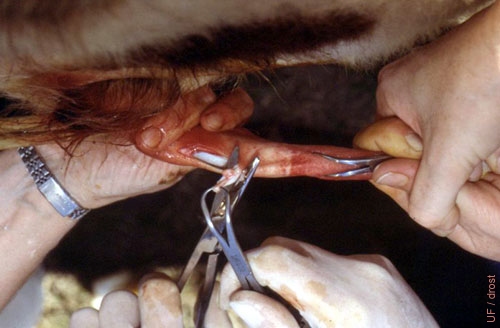
Dorsal Ligament Resection 10.
Removal of a 5 cm section of the dorsal ligament. Notice the use of large towel forceps to keep the penis extended and to handle the free end of the ligament.
Larsen RE (1983)
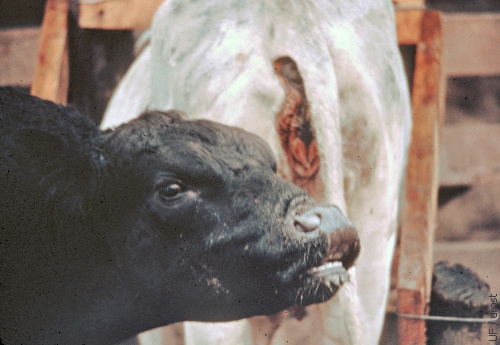
Flehmen Response.
The Flehmen response by curling the upper lip is believed to provide the vomeronasal organ with pheromones from the vaginal discharges of estrous females. Tongue movements in cattle may force fluids that contain secretions from estrous females from the oral cavity into the odor sensitive vomeronasal organ.
Larsen RE (1982)
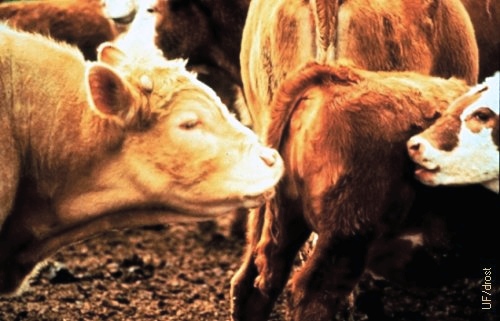
Flehmen Response.
The Flehmen response by curling the upper lip is believed to provide the vomeronasal organ with pheromones from the vaginal discharges of estrous females. Tongue movements in cattle may force fluids that contain secretions from estrous females from the oral cavity into the odor sensitive vomeronasal organ.
Drost M (1974)
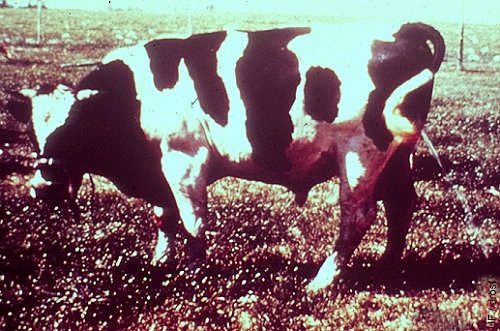
Penectomized Teaser Bull.
The penis has been transected in the perineal region. This renders the bull incapable of intromission, hence transmission of venereal diseases, as a teaser animal. The disadvantages of this procedure are that it requires a long period of recuperation and the bull will soon lose libido due to discomfort at the surgical site upon erection of the stump. The operation resembles that of a urethrostomy procedure in a feedlot steer.
Drost M (1974)
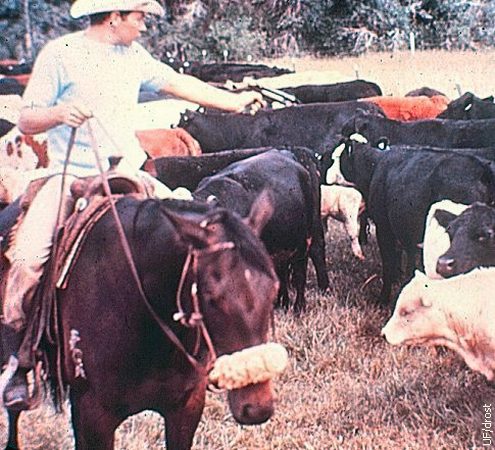
Use of a Paint Pistol to Mark Cows.
Paint capsules can be fired from a distance to mark beef cows or heifers that are observed to be in heat. They can then be segregated at a later time for artificial insemination.
Drost M (1974)
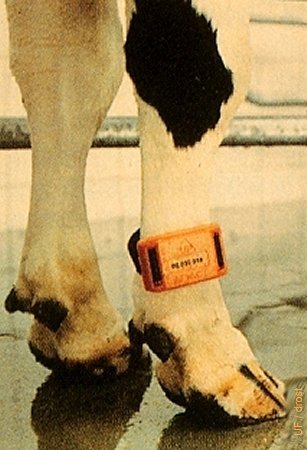
Pedometer.
Electronic heat detection by means of a pedometer applied just above the fetlock. The amount of activity / walking is recorded by the device which is read by a scanner each time the cow enters the milking parlor. An added advantage, particularly on large farms, is that the cows are inventoried each time they come into the milking parlor. A disadvantage is the initial cost of the computerized system.
Drost M (1979)


